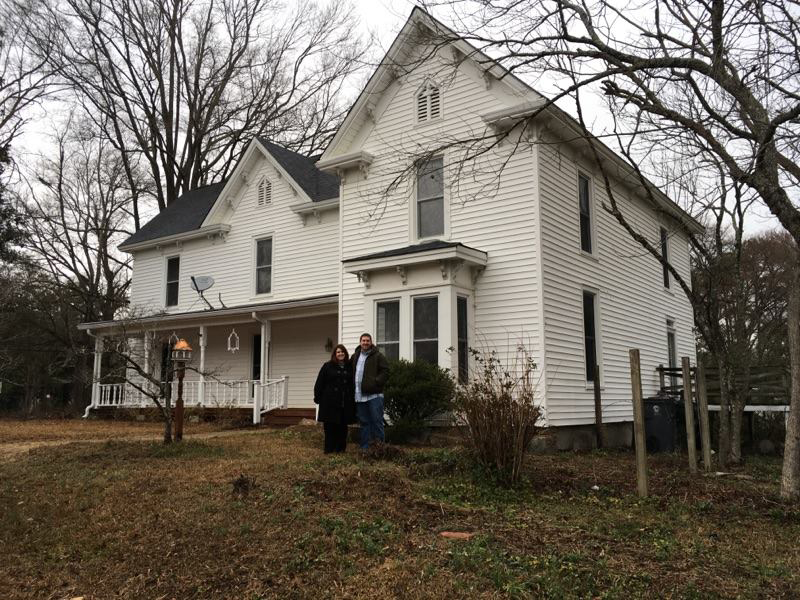The Horton Kimball house was built in 1892
By Tony Williamson
The house is situated in Wakefield just North of Zebulon. The Wakefield area began as a plantation owned by A. J. Foster in the mid 1800s. Due to its location on the Raleigh Tarboro road, a number of mills in the area, and the abundance of timber in the area, it grew into a thriving community by the late 1800s.
It was in this blossoming community that a wealthy farmer named Sidney Horton decided to build a larger home for his growing family across the road from his current home in about 1892. The home was purchased by his daughter, Mamie Horton Kimball, from his estate and stayed in the same family for almost 90 years until the late 1970s.
After Maime Horton Kimball passed away the home was purchased by E. Walton Jones in the hopes of creating apartments. His inability to acquire the needed permits was a blessing for the home and as a result the home continues to retain its original layout and many of the original features and materials.
The same year Jones sold the home to Larry Naylor who undertook the first restorations to the home. Larry stripped many layers of paint from the original wood floors and restored them, stripped many layers of paint from the exterior siding and details, painted the inside and outside, added electrical heat as the first source of heat other than the fireplaces. He relocated a door from the front to the side of the house, relocated the kitchen to a larger room in the house and added a deck off of the new kitchen. After a few years of renovations Larry Naylor sold the home to Robert and Susan Hardee who lived there for over 30 years and raised their family in the home. The home was purchased from the Hardees by Tony and Briannie Williamson in 2017 with the hopes of fully restoring and preserving the historic home.
The house is constructed in the Folk Victorian style. Folk Victorian was very popular in the late 1800s to early 1900s particularly in small rural communities. The style is a combination of a classic American farmhouse with some intricate details characteristic of more elaborate Victorian homes added. These homes are often referred to as Victorian farmhouses.
The notable Victorian details of this home include ornate brackets around the eves, small crosses in each of the gable vents, two square bay windows on the first floor, sidelights and a glass transom around the front entry and a curved staircase in the foyer.
This home was constructed at a time when construction methods were changing. As a result the house builders used a unique combination of old and newer techniques. The house sits on a foundation of large 8×8 sill beams supported by granite piers that are about 16 feet apart. Some of the timbers are almost 40 feet long and the frame is connected together using mortise and tenon joints secured with wooden pegs. On top of this foundation the main frame of the house is a combination of large 4 x 8 rough sawn timbers in the corners and on either side of any door or window openings and 2 x 4 and 3 x 4 studs. The timbers and studs are up to 20 feet long and extend from the foundation frame all the way to the eve and are capped with a 4 x 4 beam at the top. The second floor joists are supported by 2 x 8 girders that are notched into the large post and studs that extend the full height of the house. The frame is assembled using various size cut nails and includes 4 x 4 cross bracing in the corners to prevent the frame from moving side to side. The 6” lap siding is attached directly to the building’s frame, more typical of a timber frame construction without an additional layer of sheathing that is more common in homes constructed with balloon framing and newer framing techniques. The presence of skip sheathing on the roof reveals that the original roof was cedar shingles, a few remnants of which have been found in the attic.
The eight fireplaces in the home are situated in two separate chimneys. The base of the chimneys and the fireboxes are constructed of granite slabs and rubble. Below the first floor level the base of each chimney flares out to a large stack of granite slabs that is almost 12 feet across. The chimneys switch over to brick about three feet below the second floor ceiling. The brick once continued through the roof, but was dissembled to just below the roof line by a previous owner.
The interior finishes of the home include horse hair plaster on the walls, a unique bead board on the ceiling, and 4 inch tongue and groove heart pine floors. All the doors appear to be original and are constructed using through tenons secured with wooden pegs and no mechanical fasteners. Unfortunately, the mantels currently in the home do not appear to be original to the home due to the presence of the only wire nails found in the older construction of the home.
Tony and Briannie Williamson are wrapping up the first part of a full restoration of the home, begun in February 2017 when they purchased it. The first phase of renovations has focused on the interior of the home giving a needed refresh to every room. All the existing trim in the home has had many years of paint stripped and large areas of damage have been repaired. The existing door hardware has been repaired or replaced as needed. The existing bead board ceilings have been repaired and restored with a fresh coat of paint. Victorian era moldings and other details have been restored and added throughout the home matching the originals as much as possible. Needed maintenance and repairs have been undertaken to the existing electrical, plumbing and HVAC systems. The heart pine floors have been repaired and refinished. One of the largest repairs needed included replacing one of the 40 foot long 8 x 8 sill beams along the north side of the house. Due to cement that was poured against the house by a previous owner the existing beam was severely damaged from moisture and termites.
A full restoration of the exterior is planned for the future. This will include removing the existing vinyl siding and restoring the original lap siding, repairing and restoring the decorative brackets around the eves of the house, restoring the brick chimneys above the roof line, replacing the front porch and railings with as close a match to the original as possible, replace the existing vinyl replacement windows with new wood sashes that match the originals, and restoring the existing stone piers. The Williamsons are still looking for any photos of the home that may show the original details of the home to help in the restoration efforts.

